The flowering cherries of Washington, D.C., the redbuds around Lake Michigan, the saucer magnolias of the San Francisco Bay Area — wherever you live, there's probably a blooming tree that spectacularly announces that spring is here or at least is on the way. Most of these are treasured trees, the result of centuries of development by horticulturists around the world.
Considering one for your garden? It goes without saying: Do your homework. A flowering tree is a major investment of time, money and garden space. Check locally to see which trees are appropriate for your climate and site. You'll probably have dozens of varieties from which to choose. Check on eventual size, care needed and pest problems. There are individual books on many different flowering trees, or consider Michael Dirr's 952-page
Encyclopedia of Shrubs and Trees. To get you started, below are seven spring-flowering trees that are not only beautiful but practical (actually, one is not very practical in most gardens). These are solid, dependable landscape trees, as long as they're in the right place.
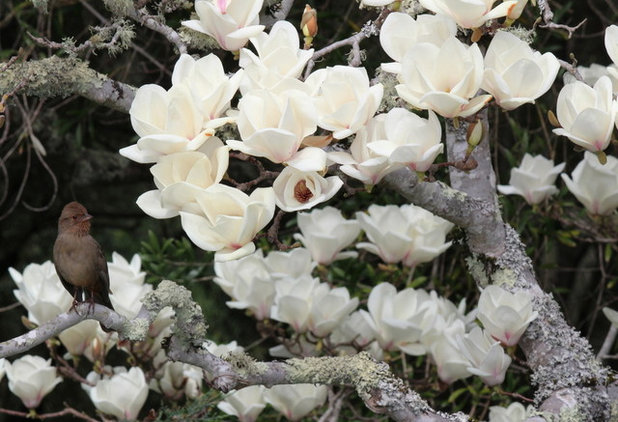 Deciduous magnolias.
Deciduous magnolias. Known for oversize flowers, from purest white to deepest purple, on bare branches, these include big shrubs and trees such as
Magnolia soulangeana, M. kobus and
M. liliiflora. There are hundreds of choices, including this unidentified species along with an unidentified bird. Some are hardy to USDA climate zone 5 and colder but also do well in mild California. Most deserve a prominent spot in a garden — even on a lawn.
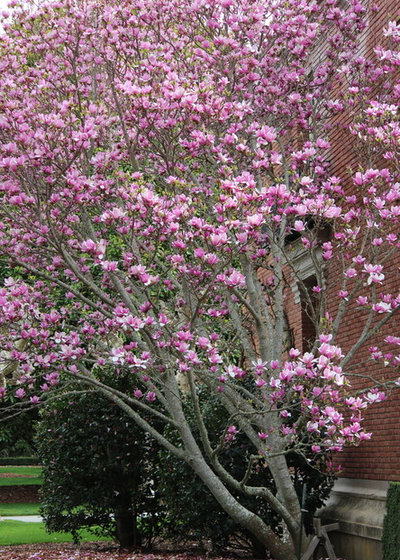 Saucer magnolia.
Saucer magnolia. Best known of the deciduous magnolias, this is a dependable medium-size tree with a substantial branch structure that looks good all year, even when leafless. Look for a variety with an ultimate size that fits into your garden and a flower you like. 'Alba Superba' has purplish buds that open pure white. 'Black Tulip' lives up to its name.
Botanical name: Magnolia soulangeanaCommon names: Saucer magnolia, tulip tree
USDA zones: 5 to 9 (find your zone)
Water requirement: Moderate
Light requirement: Full sun or partial shade
Mature size: 15 to 30 feet, depending on variety
Growing tips: Young plants can grow in a container for a few years.
More about saucer magnolia
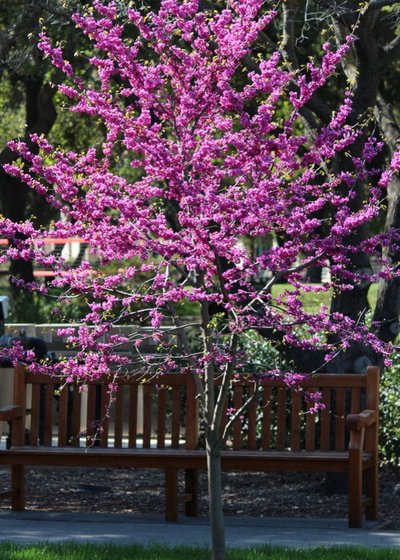 Redbud.
Redbud. Glorious purple-pink blossoms brighten early spring in many North American forests. Available in a range of graceful forms, redbud is adaptable to a wide spectrum of garden climates — in California it performs more dramatically than the native California redbud.
Botanical name: Cercis canadensisCommon name: Eastern redbud
USDA zones: 4 to 9
Water requirement: Moderate or more
Light requirement: Full sun or partial shade, especially in hot climates
Mature size: Up to 30 feet tall; compact varieties are much smaller
Growing tips: Make sure the soil drains well and is kept moist. Prune after bloom.
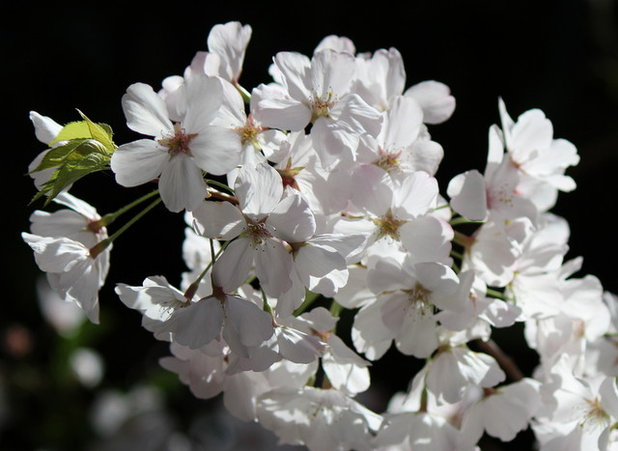 Flowering cherry.
Flowering cherry. Most loved of the flowering trees is probably the Japanese flowering cherry, the pride of Washington, D.C., originally a gift from Tokyo more than a hundred years ago. Choose from varieties of different sizes and shapes (sprawling, narrow, dwarf, columnar, weeping); flower form and color (double, single, drooping, white, light pink, deep pink); and bloom time, from early to late spring. Notable varieties include 'Kanzan', 'Shirotae' and 'Akebono'.
Botanical name: Prunus serrulata varieties and other species
Common name: Japanese flowering cherry
USDA zones: 5 to 8 or 9, depending on species and variety
Water requirement: Moderate
Light requirement: Full sun
Mature size: 12 to 25 feet tall and wide, depending on variety
Growing tips: Provide deep, well-drained soil. Look into pruning specific varieties and into potential pest and disease problems.
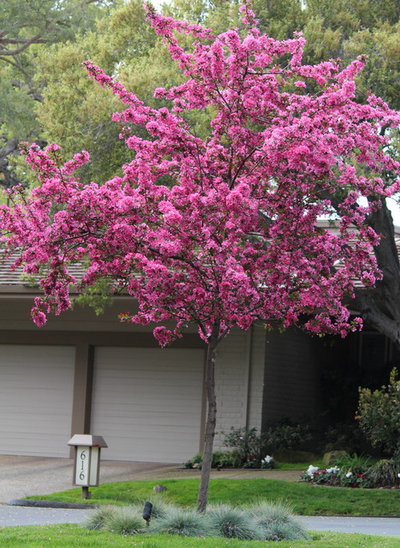 Flowering crabapple.
Flowering crabapple. One of most spectacular flowering trees, but it also offers one of the briefest shows. It is generally adaptable but doesn't do well in the dryest climates. Hundreds of varieties vary in height and flower color; a number of them bear edible fruit.
Botanical name: MalusCommon name: Flowering crabapple
USDA zones: 3 to 9, depending on variety
Water requirement: Moderate
Light requirement: Full sun
Mature size: Up to 25 feet tall and wide; dwarf varieties may be one third that size
Growing tips: Make sure the soil is well drained and kept moist. Follow the pruning directions for your specific variety.

The New York Botanical Garden
Flowering dogwood. Exquisite white or pink blooms seem to perch on layers of branches in midspring. There's deep red fall color too. This is a classic garden tree, available in many varieties (shown is 'Cherokee Brave'), colors and tree forms and with different disease resistances.
Botanical name: Cornus floridaCommon names: Flowering dogwood, Eastern dogwood
USDA zones: 5 to 9
Water requirement: Moderate; don't let the soil dry out
Light requirement: Full sun or partial shade
Mature size: Up to 20 to 30 feet tall and wide
Growing tips: Watch for anthracnose, a debilitating fungus that shows on leaves.
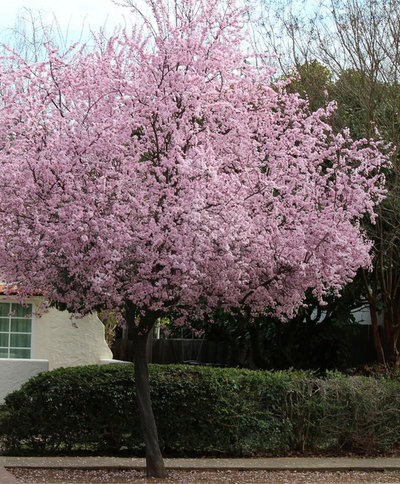 Purple-leaf plum.
Purple-leaf plum. It's not as spectacular as a flowering cherry or others, but this is a dependable, easy, versatile landscape plant — street tree, background plant or featured spring perfomer. It blooms early. Purplish foliage makes a solid display throughout the growing season.
Botanical name: Prunus cerasifera 'Pissardii'
Common names: Purple-leaf plum, flowering plum
USDA zones: 5 to 9
Water requirement: Moderate
Light requirement: Full sun
Mature size: Up to 25 feet tall and wide, or larger
Growing tips: Make sure the soil doesn't become too wet. Some flowering plum varieties bear small fruits that can create a mess underneath. Little pruning is needed, and few pests are a problem.
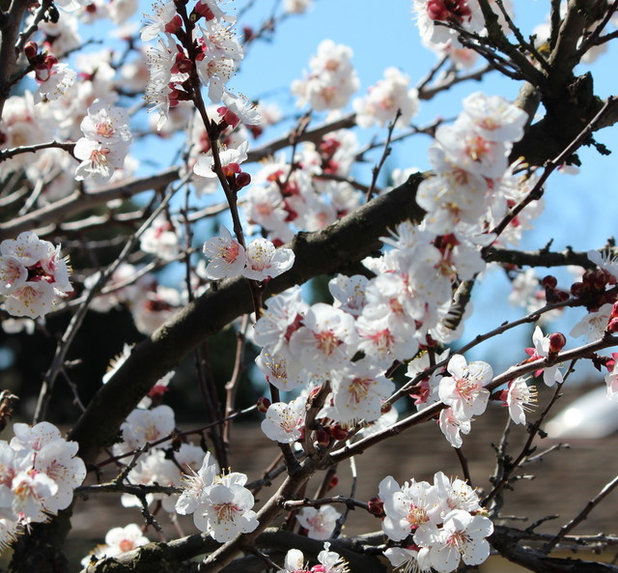 Apricot.
Apricot. I'm showing my California bias by including it here; this spring-blooming fruit tree is beautiful but not very practical for most gardens. It's fairly hardy to cold winters but produces fruit only in specific climates with enough winter chill, no frost in spring and long, dry, hot summers. The white to pinkish flowers in early spring are set off dramatically by dark weathered trunks and branches. The fruit, if you're lucky enough to grow some and have it remain on the tree until fully ripe, is priceless.
Botanical name: Prunus armeniaca, many varieties
USDA zones: 4 to 8
Water requirement: Moderate
Light requirement: Full sun
Mature size: 15 to 20 feet tall and wide
Growing tips: Keep the soil moist when the fruit is developing. Prune in late summer.
More ideas for a stunning spring garden





